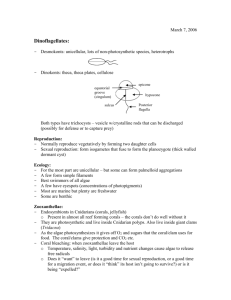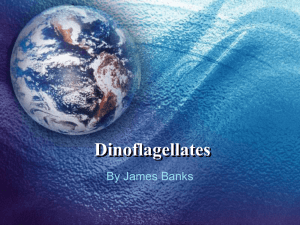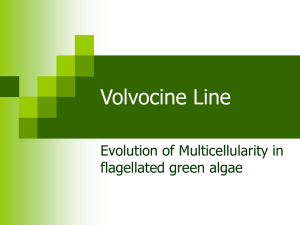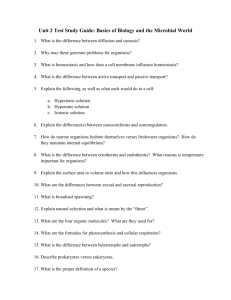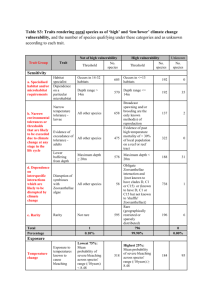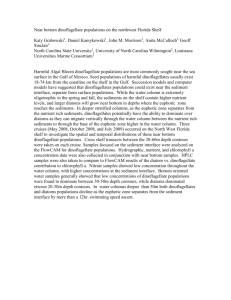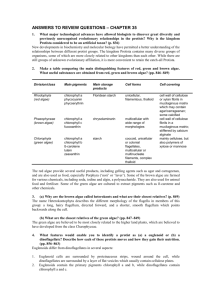PPT
advertisement
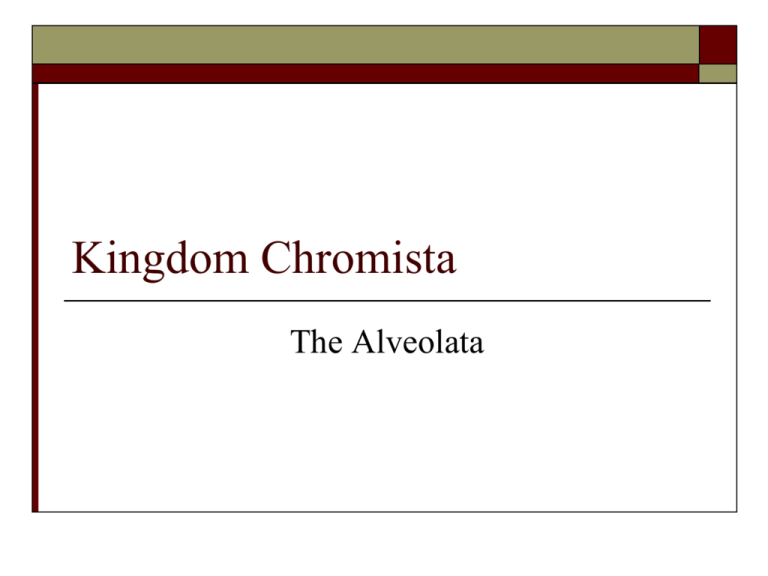
Kingdom Chromista The Alveolata Protozoan Biodiversity A guide to the major groups Species seen in lab are marked with a Alveolata Alveolata All alveolates have tiny sacs (alveoli) beneath the plasma membrane All single-celled Have tubular inner membranes (cristae) in their mitochondria (Tubies). Three major taxa with very different adaptive strategies Dinozoa Dinoflagellates – some photosynthetic, others not Important in nearshore oceans Apicomplexa (Mostly) medically important parasites; non-motile Ciliophora Ciliates – conjugation Dinoflagellates Phylum Dinozoa = Dinoflagellata Dinoflagellates Often classed with algae Cell complexity How are their cells organized? Mesokaryotes – permanently condensed chromosomes Mitotic spindle located outside of the nucleus (which remains intact during mitosis) What pigments do they possess? Single cells or chains of cells. Chlorophyll a, Chlorophyll c and Peridinin. What storage product is made? Starch and oils. Dinoflagellates Cell wall features? Most dinoflagellates are encased in plates of armor. Some are “naked” and lack these plates Thick cellulose plates encased in vesicles beneath the cell membrane Gymnodinium 2 flagella present. One trails behind One lies in groove around center of cell Cell spins slowly like a top as it swims Ceratium Gonyaulax: an armoured dinoflagellate. Cell wall is subdivided into multiple polygonal vesicles filled with relatively thick cellulose plates A “naked” dinoflagellate. Cell wall does not have thickened cellulose armour plates. Armored dinoflagellate: Know: cingulum, sulcus, epitheca, hypotheca, flagella Dinoflagellates Dinoflagellates Some have elaborate eyespots called ocelli, which have a pigmented portion and a lens-like refractive portion. Some have trichocysts, which are ejectile organelles similar to the nematocysts in Cnidarians. What other group of protists has these? Ceratium Ceratium Note: nuclei with permanently condensed chromosomes Dinoflagellates Mature dinoflagellates are haploid (1n) meiosis Dikaryotic nuclei – 2 haploid nuclei Permanently condensed chromosomes Reproduction Mostly asexual Reproduce by fission A few can reproduce sexually Gametes formed by mitosis (not meiosis) because the cells are already haploid. Gametes (1n) are motile Zygotes (2n) formed by fusion of gametes also motile Dinoflagellates Ecology 90% are marine 10% freshwater About 50% are photosynthetic; the rest are heterotrophs (parasites) Photosynthetic dinoflagellates are second only to diatoms as primary producers in coastal waters. May be free-living or symbiotic Zooxanthellae - symbionts of cnidarians and others Vital to the growth and survival of coral reefs Zooxanthellae Dinoflagellate endosymbionts of animals and protozoa Coral reef builders Zooxanthellae Symbiotic dinoflagellates found in many marine invertebrates Genus Symbiodinium Sponges, corals, jellyfish, Tridacnid clams and flatworms Also found within protists, such as ciliates, foraminiferans, and colonial radiolarians. Zooxanthellae Zooxanthellae Endosymbionts of animals and protozoa In coral polyps zooxanthellae are found in the second layer of cells below the epidermis; one algal cell per animal cell. Important components of reef building corals* Provide them with nutrients Remove waste Contribute to the production of calcium carbonate skeletons * More about this when we study Cnidarians Zooxanthellae Mutualism Host organism ingests the dinoflagellate and incorporate it into its own tissues without harming it. Dinoflagellate divides repeatedly, and begins to manufacture carbohydrates which are provided to the host. Many corals get all their food from the zooxanthellae; build reefs much faster with the dinoflagellates present in their tissues. Zooxanthellae Zooxanthellae Recall observations on zooxanthellae in tissues of Aiptasia anemones from S219 aquarium Cassiopeia jellyfish (aquarium) also have zooxanthellae and typically rest upside down in shallow mangrove beds. This provides maximum sun exposure for symbionts Jellyfish also feeds on passing zooplankton Blue structures are vesicular appendages that hold zooxanthellae Aiptasia anemone with zooxanthellae The upper layer of the Acropora sp. is the epidermis. The lower layer is the gastrodermis. Within the cells are round to oval golden spheres. These are the zooxanthellae. Cassiopeia, the Upside-Down Jelly or Mangrove Jelly (Figure 7), generally lies on upside-down on the substrate where it tends its internal garden of zooxanthellae, which give it a greenish color. While there, the bell margins pulsate creating a current across the oral surface where plankton and other particles are subdued by nematocysts and caught in a gelatinous coating. The captured particles are carried to the mouth or to other secondary mouths that occur on the oral arms. These are animals of warm, shallow water of the West Indies, the Pacific, and the Indian Oceans. Coral Bleaching = loss of zooxanthellae Causes – discussed with Cnidarians Bioluminescent Dinoflagellates Bioluminescence Some dinoflagellates are capable of producing light - bioluminescence Molecules made by the organism produce light in a chemical reaction. Luciferin and luciferase Same reaction that occurs in fireflies Health Issues Many dinoflagellates produce neurotoxins Poisons that injure the nerves of marine life that feed on the dinoflagellates May cause massive kills of fish and shellfish, as well as other forms of marine life. If animals containing these toxins are eaten by humans, the result may be illness or even death. Neurotoxins affect muscle function, preventing normal transmission of electrochemical messages from the nerves to the muscles by interfering with the movement of sodium ions through the cellular membranes Health Issues These toxins in the water can blow inland in sea spray and cause temporary health problems for people who live near the coast. The toxin from Gonyaulax catenella is so toxic that an aspirin sized tablet of the poison could kill 35 people; it is one of the strongest known poisons Neurotoxins Saxitoxin - most common dinoflagellate toxin Brevitoxin 100,000 times more potent than cocaine Found in North American shellfish from Alaska to Mexico, and from Newfoundland to Florida Causes fish kills May also cause poisoning in humans when it accumulates in the tissues of shellfish Red Tides Population explosions of dinoflagellates that can color the water red. Shellfish contain high levels of toxins during these times Boat Gonyaulax and views of red tides A red tide results from a population explosion of dinoflagellates (an algal bloom). Cell densities are so high that they turn the water a red color. Bioluminescent Red Tide Noctiluca Noctiluca - a bioluminescent marine dinoflagellate; also causes red tides. Can feed heterotrophically by using its longer posterior flagellum to capture prey. Neurotoxins Humans may be poisoned: By eating contaminated fish - Ciguatera Or by eating shellfish, such as clams or mussels paralytic shellfish poisoning or PSP. Poisoning is serious but not usually fatal. Lethal concentrations lead to death from respiratory failure and cardiac arrest within twelve hours of consumption Old rule of thumb was that shellfish should only be eaten during months with an "R" in them, and not during May to August. Summer brings runoff of nutrients and blooms of dinoflagellates. NOT VERY RELIABLE! Pfiesteria piscicida Note the long flagella Ulcers on fish caused (?) by Pfiesteria Pfiesteria and some of its relatives cause death in fish and respiratory and neurological complications in humans Ciliates Phylum Ciliophora Functional groupings of ciliates Holotrich- uniform ciliation Heterotrich- possess membranes &/or cirri Peritrich- cilia only around the cytostome Colonial-living in colonies Suctorian- a clade of Ciliophora possessing hollow feeding tentacles An assortment of freshwater ciliates- biodiversity! This figure shows 167 species- about 9500 species are known Ciliophora (ciliates) A major clade within the Alveolates. Synapomorphies* of ciliates include: Ciliated pellicle and associated kinetodesmata Dimorphic nuclei Conjugation Primarily holotrophic - few parasitic. Many can form cyst stage (resting stage). *Shared, derived characteristic – something NEW! c Ciliates Paramecium Paramecium bursaria Stentor coeruleus Vorticella Stylonychia Cirri ciliary organelles used for food handling and locomotionform membranes or bundles Ciliophora Euplotes a heterotrich ciliate showing complex cirri used for feeding and locomotion Euplotes Spirostomum Didinium http://www.uga.edu/protozoa/portal/images/movies/didinium.mov Acineta Sphaerophrya Acineta Acineta Balantidiasis – Balantidium coli Most cases are asymptomatic. Diagnosis is based on detection of trophozoites in stool specimens or in tissue collected during endoscopy. Clinical manifestations, when present, include persistent diarrhea, occasionally dysentery, abdominal pain, and weight loss. Symptoms can be severe in debilitated persons. Repeated stool samples necessary to find trophozoites Treatment: Tetracycline with metronidazole and iodoquinol as alternatives Trophozoites Cyst B. coli trophozoites Ichthiopthirius multifilis (Ich) Common parasite of freshwater and marine fishes Trophozoite burrows in skin Mature trophozoite leaves fish and encysts. Multiple mitoses produce hundreds of “swarmers” that reinfest fish. Ich trophozoite in fin of freshwater drum M. C. Barnhart


